TMU-VPN - GlobalProtect Installation for Mac

Use TMU-VPN for a secure connection to TMU's Administrative system via the Internet. To use TMU-VPN, you will need to install and use client software called GlobalProtect which allows authorized users' access. It provides further security by creating a Virtual Private Network (VPN), which is like a “secure tunnel” through which all communication between the user PC and TMU must pass. All data transmissions are “encrypted” so that they cannot be read while travelling across the Internet. GlobalProtect runs on your PC, laptop computer or mobile device, protecting you with the same security policies that protect the sensitive resources on Toronto Metropolitan University (TMU) network.
Requirements
- Access to the Internet
- A valid my.torontomu username and password
- VPN access enabled
- Two-Factor Authentication enabled for "applications that require two-factor authentication"
Note: If you do not meet or understand the above requirements, contact the CCS Help Desk for information before proceeding.
Download, Install and use TMU-VPN:
Before you download and install TMU-VPN, you will need to request VPN access by visiting https://my.torontomu.ca, navigate to the Self Service in your Personal Account where you can manage your VPN access and requests.
To use TMU-VPN, you will need to setup two-factor authentication. Please complete the instructions outlined on the two-factor authentication page before proceeding with the download and install of TMU-VPN, GlobalProtect.
Only for Mac OS 11 or above, theGlobalProtect is available for download, GlobalProtect.pkg.
To use TMU-VPN, you will need to install and use the GlobalProtect client software. This is the software included in the file you downloaded.
1. Before install, make sure that the GlobalProtect.pkg file is located on your Mac.
2. Select the GlobalProtect.pkg under
Downloads and a Welcome to the Global Protect Installer screen will display. Select Continue.
3. You may see the Select a Destination screen display. Select Continue.
4. At the Custom Install on "Macintosh HD" screen, make sure GlobalProtect is checked. Select Continue.
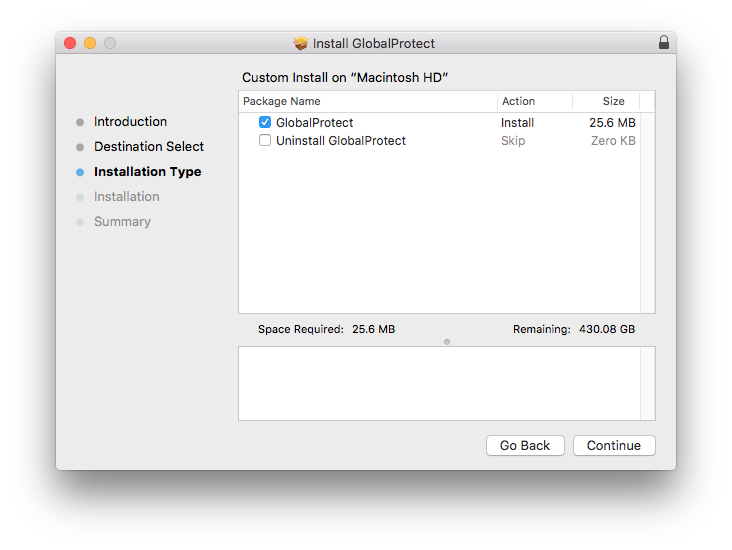
5. A window will display specifying the space required. Select Install for a standard installation.
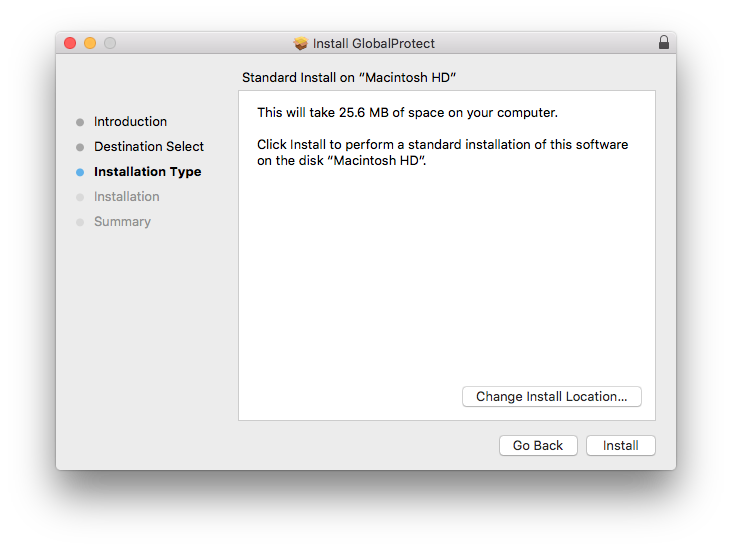
6. The installer will prompt for the administrator’s password to install the software. Please enter the password and select Install Software.
7. The software will install and a window saying "The installation was successful" will display. Select Close.
1. After installation, GlobalProtect will open a Welcome to GlobalProtect window. Enter the portal address as net.torontomu.ca and select Connect.
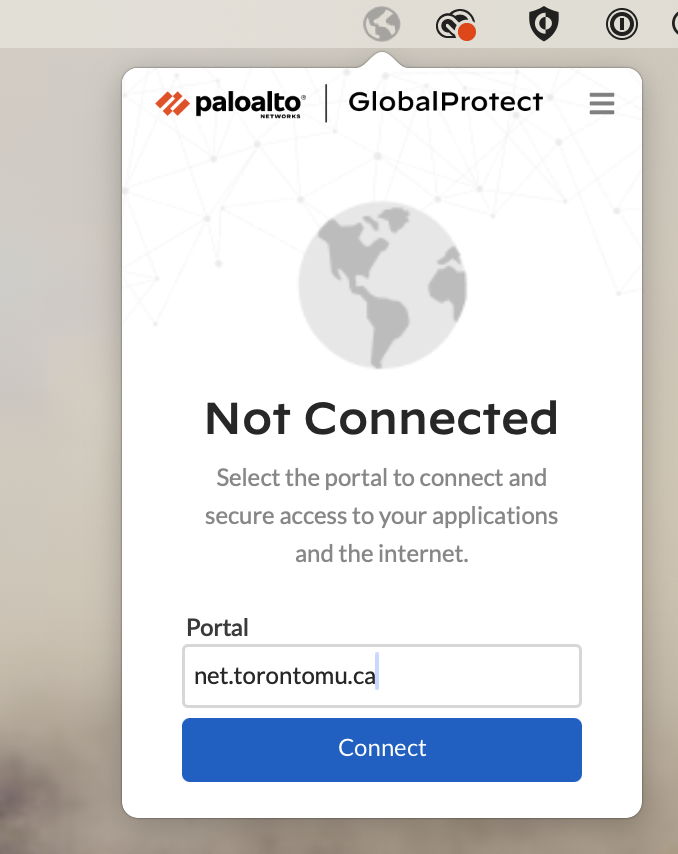
2. Depending on the version of Mac OSX you are running you will have to complete the following when starting GlobalProtect for the first time.
For the first time running "TMU-VPN", go to the Mac OS System Preferences then Security & Privacy. On the General tab select the allow button for "Palo Alto Networks", to allow the Mac OS to run the VPN software from now on.
2.1a You will see a "System Extension Blocked" pop-up, select "Open System Setting".
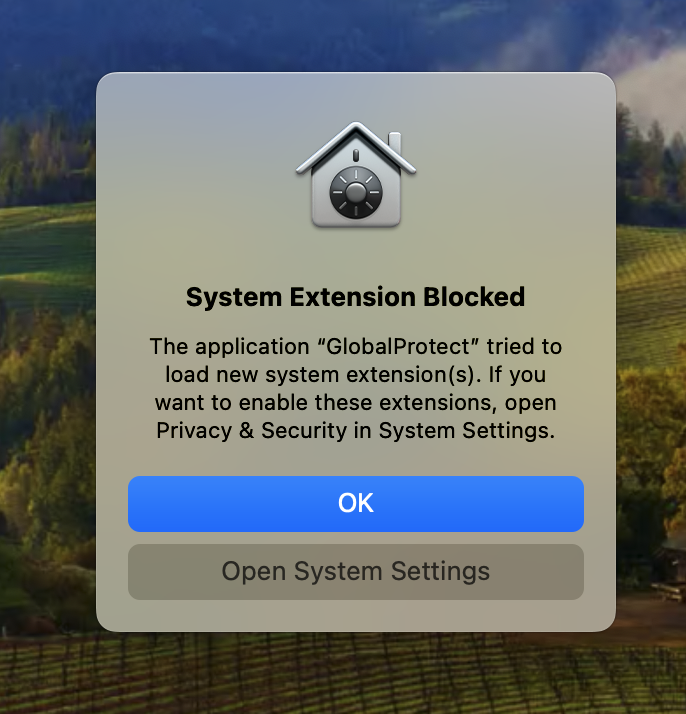
2.1b Select "Allow" under the Security section.
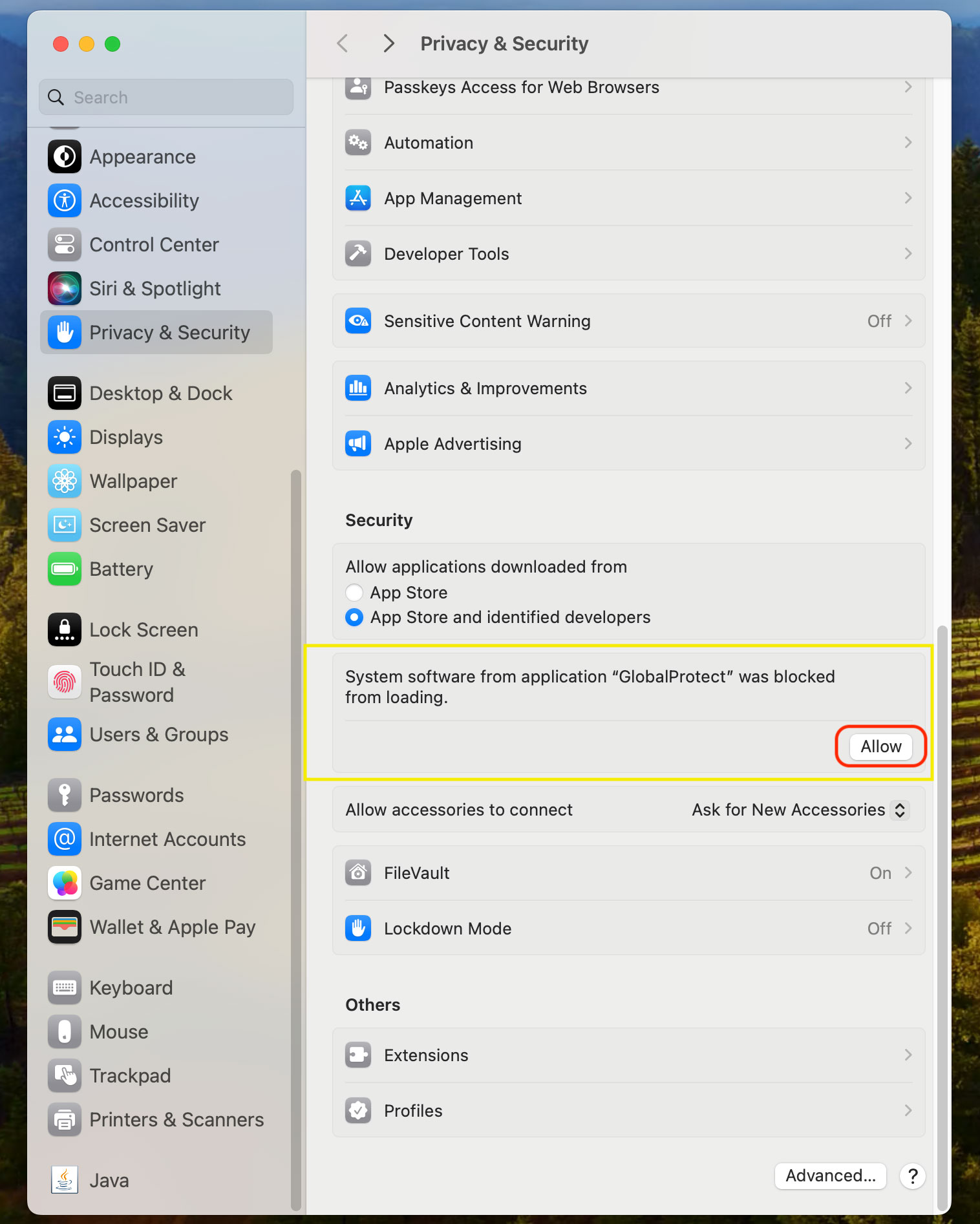
2.1c Select "Allow" on the "GlobalProtect would like to filter network content" pop-up.
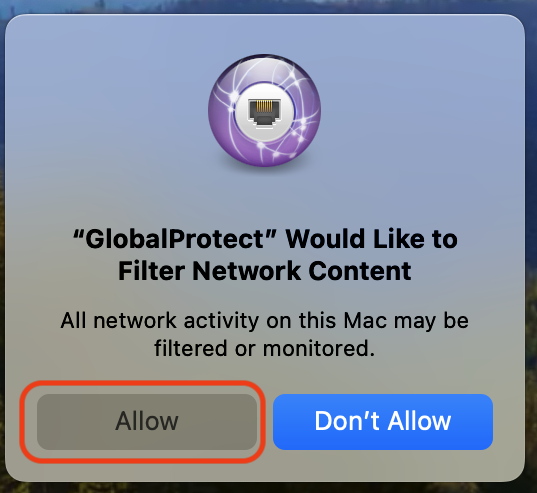
3. At TMU Login screen enter your my.torontomu username and password. Select Log in.
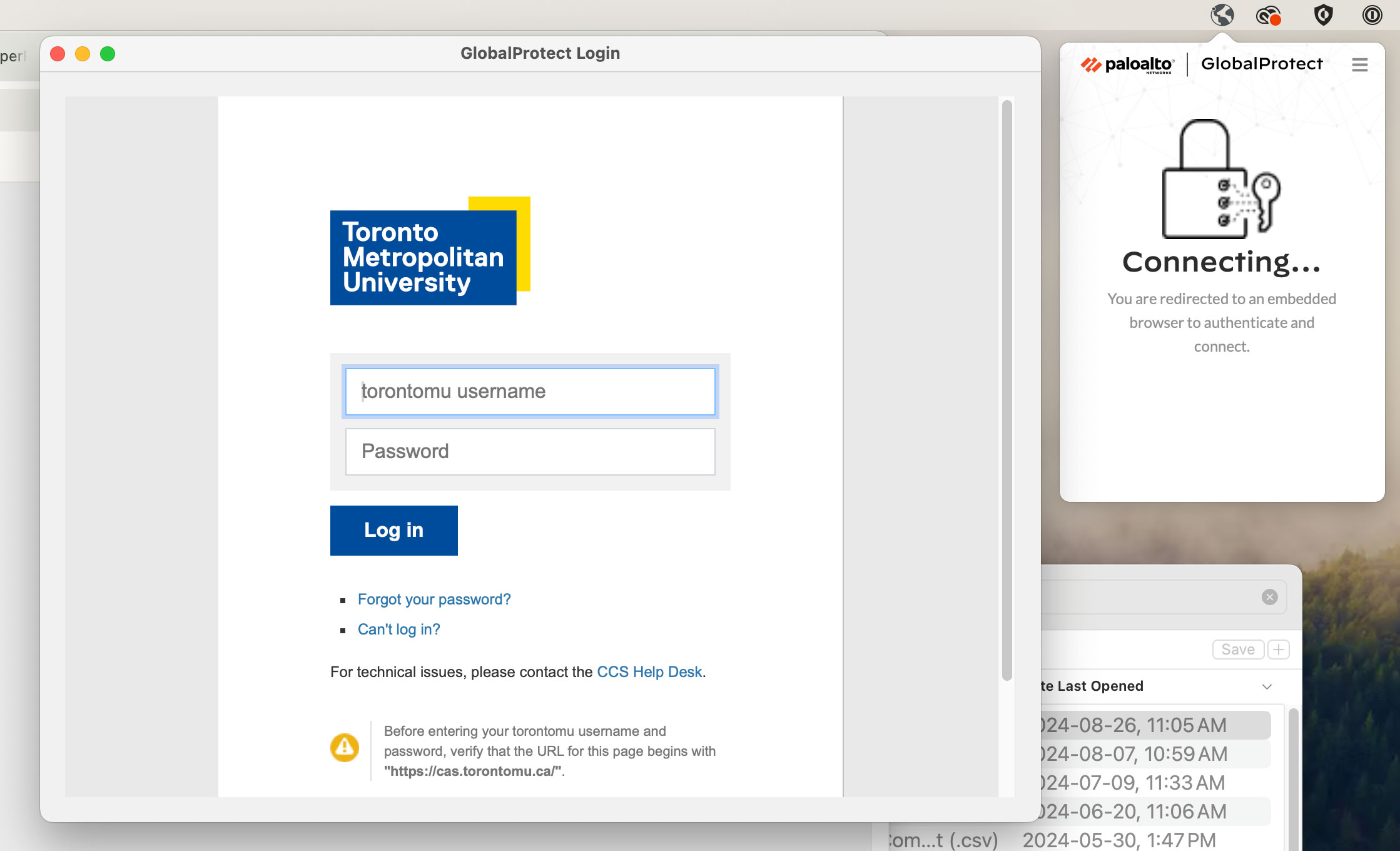
4. Next you will be prompted for your Two-Factor Verification Code. You can select the checkbox to trust this browser for 30 days, so that you will not be prompted during that time period.
Note: When GlobalProtect software is updating or if your PC is idle; GlobalProtect may need to reconnect and you may be prompted for the Verification Password again.
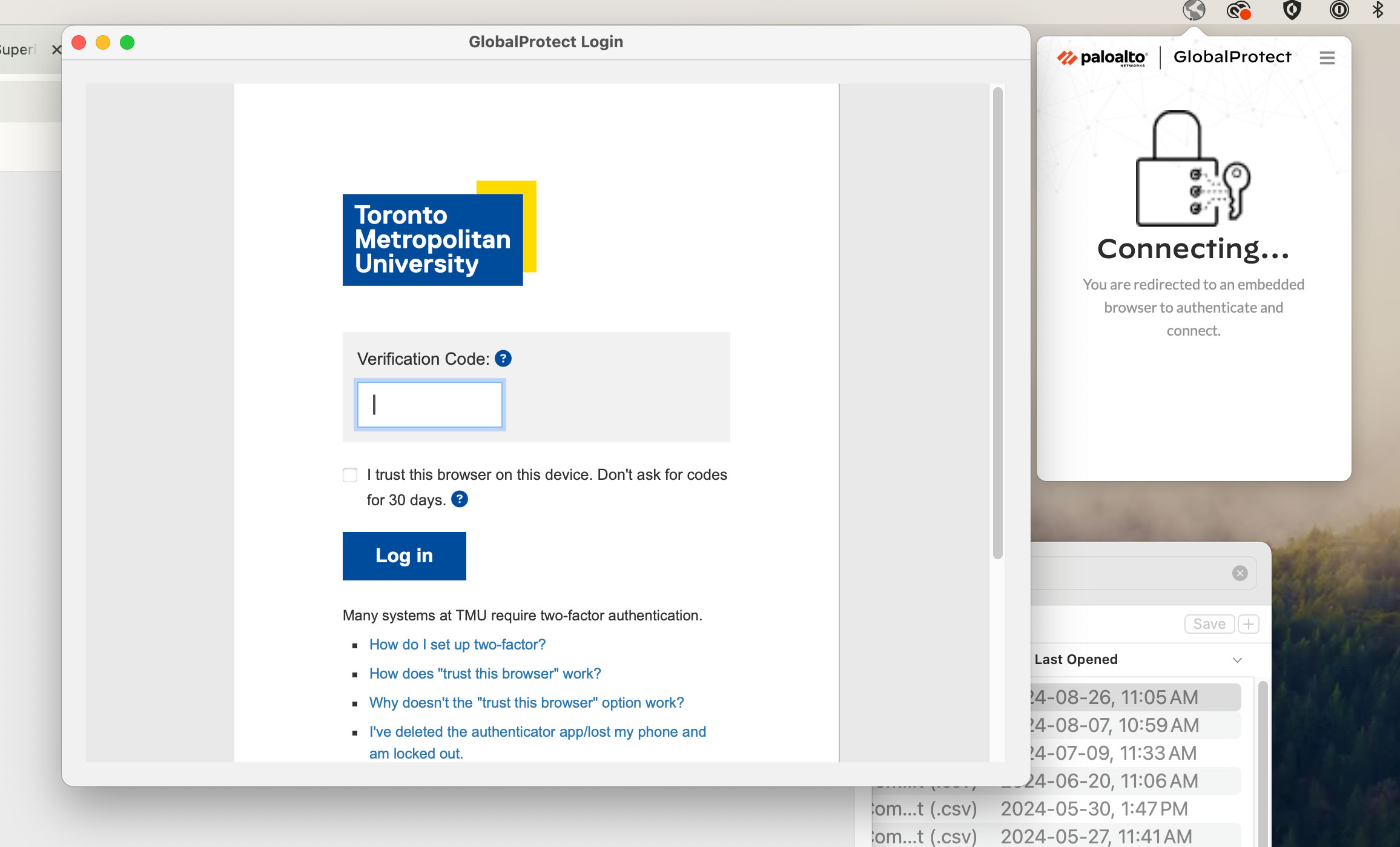
5. A Global Protect Connected window displays when connection is made. You can now access sites that require VPN.
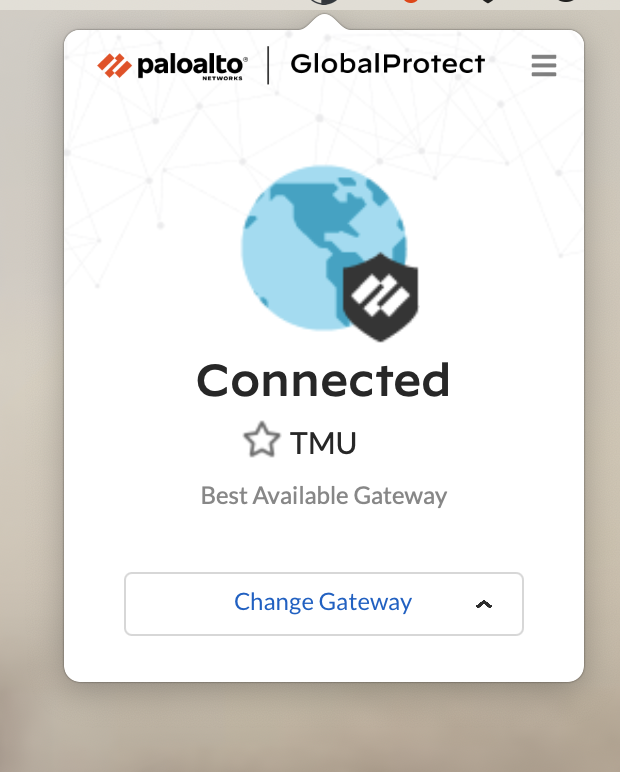
6. When you are finished using GlobalProtect, select on the GlobalProtect icon found on your system tray. Next select on the setting gear at the top right of the screen and select Disconnect. This will end your connection to VPN.
7. When you have the new TMU-VPN up and running you should uninstall the old VPN, Tunnelblick.
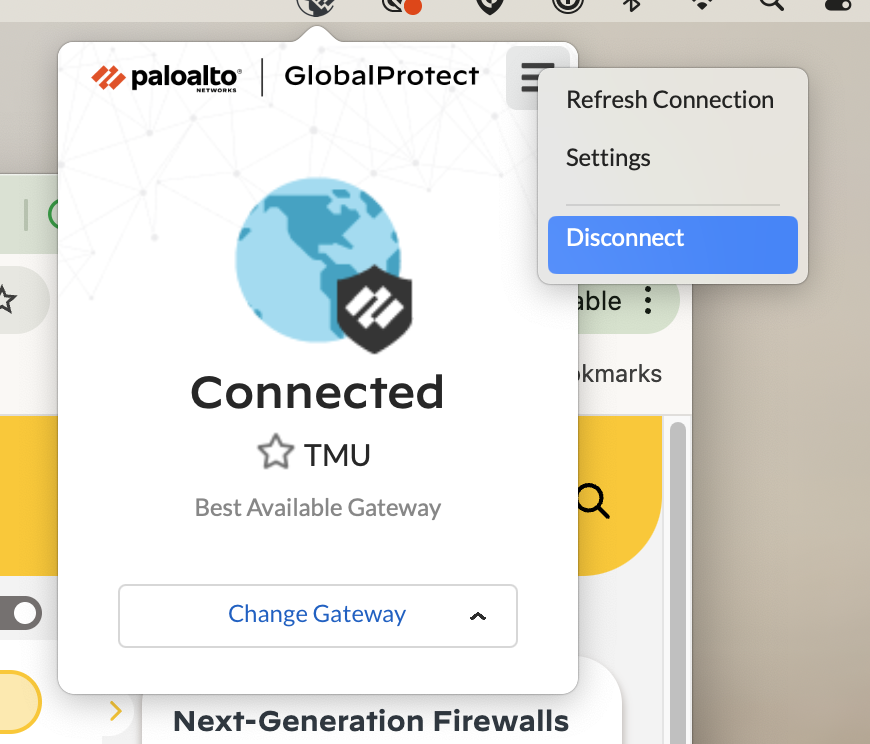
Remove old VPN, GlobalProtect
If you are using an old version of GlobalProtect and need to uninstall it, you can do the following.
1. If the GlobalProtect.pkg file is located on your Mac you can use this to uninstall. Select the GlobalProtect.pkg under Downloads and a Welcome to the Global Protect Installer screen will display. Select Continue.
2. At the Custom Install on "Macintosh HD" screen, make sure Uninstall GlobalProtect is checked. Select Continue.
3. GlobalProtect will be removed from your system.
Remove old Open VPN, Tunnelblick
If you are still using the old Open VPN software, Tunnelblick, please complete these instructions.
To uninstall use a program such as AppCleaner to completely remove all files associated with Tunnelblick.
- From the free Mac software (external link) website, select on AppCleaner and download it.
- Run the AppCleaner application.
- Drag and drop Tunnelblick to this application.
- Check that Tunnelblick and all related files are selected. Select Delete to remove all the Tunnelblick files.
Connect and Deactivate VPN Access
1. Select the GlobalProtect icon in the system tray and then select Enable.
2. At TMU Login screen enter your my.torontomu username and password. Select Log in.

3. Next you will be prompted for your Two-Factor Verification Code. You can select the checkbox to trust this browser for 30 days, so that you will not be prompted during that time period.
Note: When GlobalProtect software is updating or if your PC is idle; GlobalProtect may need to reconnect and you may be prompted for the Verification Password again.

4. A Global Protect Connected window displays when connection is made. You can now access sites that require VPN.

When you are finished using GlobalProtect, select on the GlobalProtect icon found on your system tray. Next select on the Setting gear at the top right of the screen and select Disconnect. This will end your connection to VPN.

FAQ
The VPN status icon, which displays on the system tray at the top of the screen, will indicate the current connection state:
 GlobalProtect is connected successfully. This also displays when you connect your laptop from home or a TMU untrusted network like wireless networks.
GlobalProtect is connected successfully. This also displays when you connect your laptop from home or a TMU untrusted network like wireless networks. GlobalProtect is not connected, either because authentication failed or you chose to deactivate your connection.
GlobalProtect is not connected, either because authentication failed or you chose to deactivate your connection.
Remove old VPN, GlobalProtect
If you are using an old version of GlobalProtect and need to uninstall it you can do the following.
1. If the GlobalProtect.pkg file is located on your Mac you can use this to uninstall. Select the GlobalProtect.pkg under Downloads and a Welcome to the Global Protect Installer screen will display. Select Continue.
2. At the Custom Install on "Macintosh HD" screen, make sure Uninstall GlobalProtect is checked. Select Continue.
3. GlobalProtect will be removed from your system.
Remove old Open VPN, Tunnelblick
If you are still using the old Open VPN software, Tunnelblick, please complete these instructions.
To uninstall use a program such as AppCleaner to completely remove all files associated with Tunnelblick.
- From the free Mac software (external link) website, select on AppCleaner and download it.
- Run the AppCleaner application.
- Drag and drop Tunnelblick to this application.
- Check that Tunnelblick and all related files are selected. Select Delete to remove all the Tunnelblick files.
If your Mac is a TMU computer and supported by CCS, please contact the CCS Help Desk at help@torontomu.ca or extension 556806; otherwise, contact the person who has administrator rights on the computer.
This may be caused by entering an incorrect or invalid my.torontomu username, password or verification code. Make sure you are entering your my.torontomu username and password. Remember that usernames and passwords are case-sensitive. If you are able to log on http://my.torontomu.ca using your my.ryeson user name and password, the problem may be your two-factor authentication setup. Try resetting your two-factor authentication by revoking your two-factor authentication and then reactivating two-factor authentication.
Follow the Deactivate GlobalProtect instructions.
If you are connecting from an Administrative network, not Academic or from off campus or TMU, and require full VPN to access your application, please do the following:
1. Select on the GlobalProtect icon found on your system tray. Next select on the Gateway dropdown selection and choose TMU. You will now have full VPN access.

2. When you no longer need access to your application that required full VPN, you can disconnect. Select on the GlobalProtect icon found on your system tray. Next select on the Gateway dropdown selection and choose Best Available.

Select the GlobalProtect icon from the system tray. Select the Setting gear at the top right and select About. This will display the version of GlobalProtect that you are using.
GlobalProtect is pre-set to check if there are new versions available. Once you have installed GlobalProtect and establish a VPN connection, the software will download the new version and put it in a queue. It will install by itself. You may see a message "GlobalProtect agent upgrade is in progress. Please wait, application will restart once the upgrade is complete."
If the information here did not help to resolve your problem, you can contact the CCS Help Desk at help@torontomu.ca. Please include details of:
- Your operating system version, e.g. Windows 7 Professional with SP1, Mac OS X 10.10.2 etc. Your GlobalProtect Client version
- Your ISP (Internet Service Provider)
- Your TMU email address
Important Note
TMU is taking the issue of security very seriously. It is imperative that you disconnect your VPN session when you are finish with accessing any of the TMU systems or when your computer will be left unattended and unsecured for some period of time during the day.
Leaving your active VPN session open and unattended provides others with the opportunity for message forgery and other misuse, attributing them to you and creating an embarrassment to you and possibly compromising the integrity of TMU. This is especially important for people who share computers or have their computer located in a public area.
Some basic safeguards which can be used to aid data security are:
- Disconnect your VPN session and logout from your PC during periods of absence. (e.g. coffee break, lunch, meetings etc.)
- Lock your office or room during periods of absence during normal working hours.
- Always use a screen saver password and a computer power-on password.